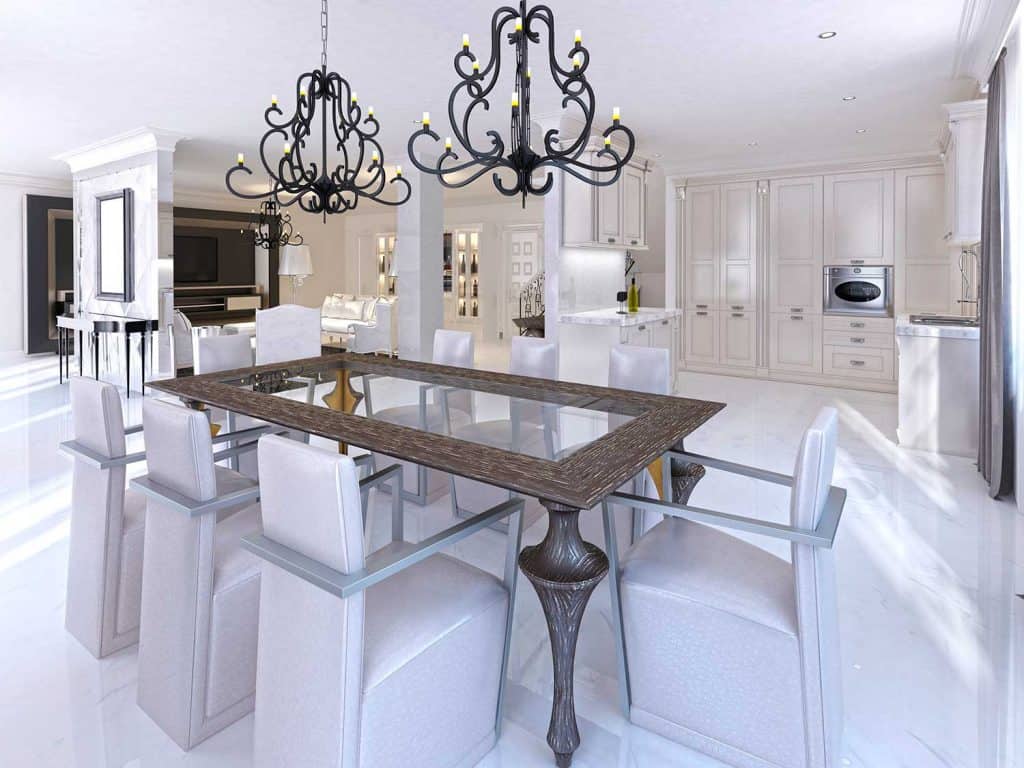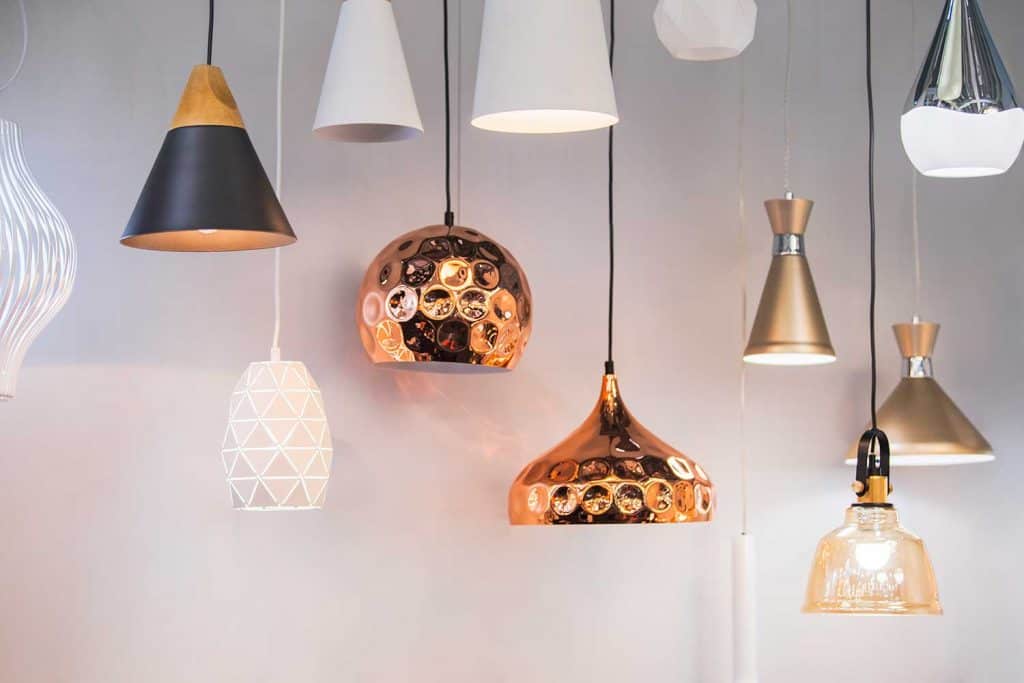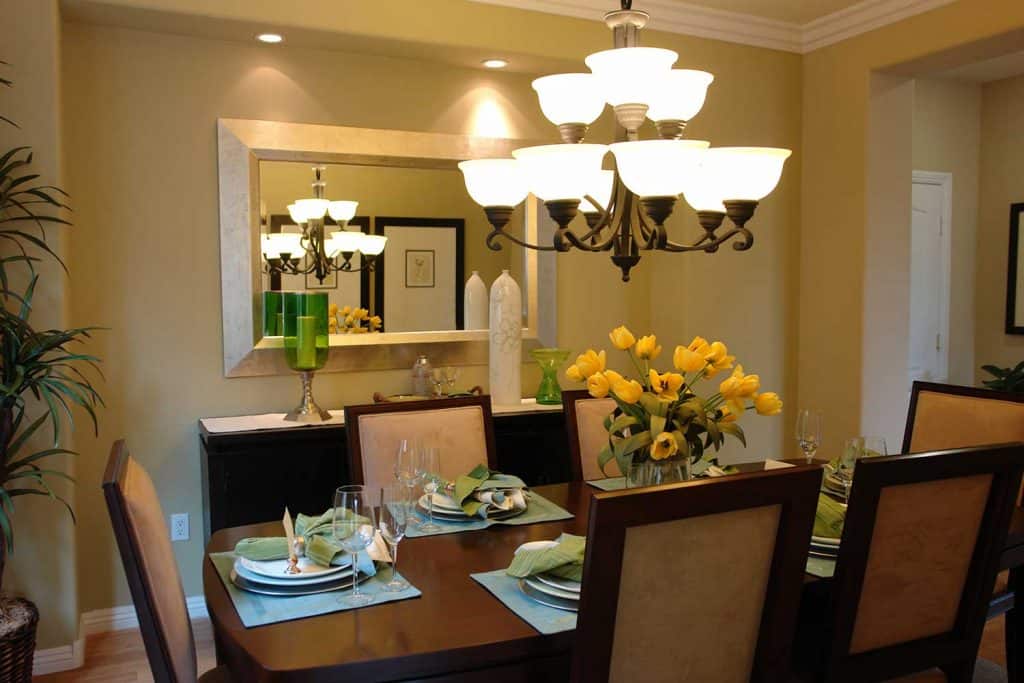While the addition of two different chandeliers may not sound like a conventional issue, lighting is always crucial in the home. A chandelier is a commanding, ornate piece of the room. The presence of multiple chandeliers, a shimmering staple of luxury, might cause some hesitation. The aesthetic and overall design of your room would be greatly affected. But don’t worry, because we’ve researched the pros and cons of adding differing chandeliers to your home.
It is generally advised that you should not include two different chandeliers in one room. Unfortunately, differing chandeliers would ultimately steal each other’s attention. This can include any chandeliers of the same size. Chandeliers are simply too eye-catching and extravagant compared to other common fixtures. Not only would the focal point of the room feel unclear, but the overall lighting would likely become unbalanced.
Chandeliers are often filled to the brim with personality, and they can add wonders to your room. But there are an extraordinary number of choices. In fact, they can cost anywhere from thirty dollars to hundreds and even thousands of dollars. Keep reading to learn about choosing the right chandelier for you and how to handle multiple chandeliers.

Do Chandeliers Have To Match?

We sometimes add affiliate links and content that was curated and created by our team with the help of advanced ai tools to help showcase the best design styles.
The best interior designs will mainly adhere to consistency, which is always naturally attractive. Therefore, it is ideal to match your chandeliers; sometimes, they are even sold in prepared sets. Just remember, two chandeliers can overpower the room. Let's have a look at the pros and cons of a matched pair.
Click here to find this pair of chandeliers on Amazon.
Symmetrical Vs. Cluttered-Looking
Mixed chandeliers achieve symmetry. For example, you could attempt to hang a unique chandelier in between two matching smaller ones. However, this approach would likely make the room feel cluttered. They will probably overtake the focal point in the room and distract from the scene below. This can feel especially confusing in homes where the living room, dining room, and kitchen flow right into each other.
Chandeliers draw the eye upwards, where they typically have exclusive command of their space. This means that chandeliers will demand more attention than other fixtures in the room. But chandeliers still need to blend in with the scene smoothly. Finding that balance can be difficult. Fortunately, chandeliers can greatly vary in size and design, like any other fixture in the home. As such, it is still possible to balance the room.
Light Distribution
Besides the aesthetic advantages, matching your chandeliers will also be the most efficient way to even out the room's light distribution. Lighting is a powerful tool, though often underestimated. Lighting can accent or define your interior design, like any traditional art. Building an organized, even amount of lighting in your room is an entire process of its own.
This is because disrupting a room’s light flow can become genuinely disastrous. For example, lighting the dining room with two different chandeliers would be frustrating over a long table. Lighting would be uneven above either end of the table, where people are meant to converse.
Should Foyer And Dining Room Lighting Match?
It is important to remember that the purpose of a foyer is to make introductions. This single room would define the first impression of your home. Therefore, the foyer should represent the overall artistic themes of the rest of the rooms. You can read "How Big Should Entryway Chandelier Be."
It is actually typical to use different chandeliers in different rooms, so long as they visually complement each other. Likewise, the lighting throughout your rooms should flow in the same manner. Creating a comfortable flow is a core principle of any interior design. Although the lighting in different rooms doesn’t have to be identical, they should absolutely overlap comfortably.
Can You Mix Lighting Styles?

Lighting styles can be as broad as any other element of interior design. There are countless options, and they can represent very different cultural or historical personalities. This includes everything from traditional to contemporary, or European to country style.
Most people likely prioritize the lights that are meant to fill an entire room. But there are smaller lights, like reading lamps, that can affect the room’s total volume of light. There are always a variety of lights that have different purposes, from sconces to lamps. So, mixing your lighting styles will probably be an essential piece of your interior design.
However, lighting styles must also agree with each other. The ultimate trick is to combine lighting styles between rooms. So long as all of the rooms speak the same visual language, they can potentially have different conversations.
How Do You Choose A Dining Room Chandelier?
Like every other addition to your home, it’s important to prioritize safety and practicality before artistic design. And more so than ever, many will be mindful of how expensive a new chandelier could be. The best chandelier should balance durability, appearance, and cost. The material and size of the chandelier will greatly determine these factors. So, it’s best to consider these things before you fully commit to one style or another for your dining room.
Practical Chandeliers
Click here to see this chandelier with a dimmer on Amazon.
Firstly, you’ll want to consider the materials. Wood and iron may fit a rustic scene, but a wooden fixture might be too vulnerable for certain environments. Chandeliers can always use a sturdy material with the desired finish. Then again, some materials can be much heavier than one another. If you require a larger chandelier, you should be prepared to purchase extra supports for the ceiling. This is essential to ensure the safety of the room.
The proportions of the surrounding room can typically determine the size of a chandelier. For example, in a dining room, the dining table itself can demand a smaller chandelier. There are actually some universal suggestions for measuring the room accordingly. It is commonly advised to hang a chandelier around 30 to 36 inches above the dining table. With such measurements in mind, your chandelier will certainly need to be smaller or larger. To learn more, you can check out "How Big Should Dining Room Chandelier Be."

Chandeliers can also produce various levels of light. You may need to decide between a stronger or weaker light source to balance out your unique dining room. But some chandeliers have a dimmer built directly into the design. The central purpose of the dining room is right in the name. So, it’s crucial to light the dining table appropriately, where people will spend most of their time.
Complementary Chandeliers
Click here to find this coastal chandelier on Amazon.
Next, you can freely shop around for chandeliers that will fit the atmosphere of your dining room. It’s typical for chandeliers to complete the room rather than command it. For example, you may have a nautical style dining room because you live near the coast. If so, then the chandelier probably shouldn’t be a modern, industrial contraption. And a crystal behemoth probably isn’t cozy enough for a vintage style dining room. You can make a statement with your chandelier without creating disorientation.

Affordable Chandeliers
Click here to see this affordable crystal chandelier on Amazon.
There are also a surprising number of affordable chandeliers that are just as elegant and bold as their expensive counterparts. You don’t need to sacrifice size and quality for personality. However, it is also important to consider that you probably don’t want to replace cheaper chandeliers regularly. There are so many options; it is best to rely on customer reviews.
Summary
Although chandeliers are often thought of as expensive, overbearing fixtures, they can be a comfortable and important addition. Even multiple chandeliers can work together, so long as style and function are considered equally. The chandelier is a bold piece of any room, and now you know just how to choose the ideal fixture. And you won’t need to overspend to make sure the styles and lighting of your rooms flow just right!




